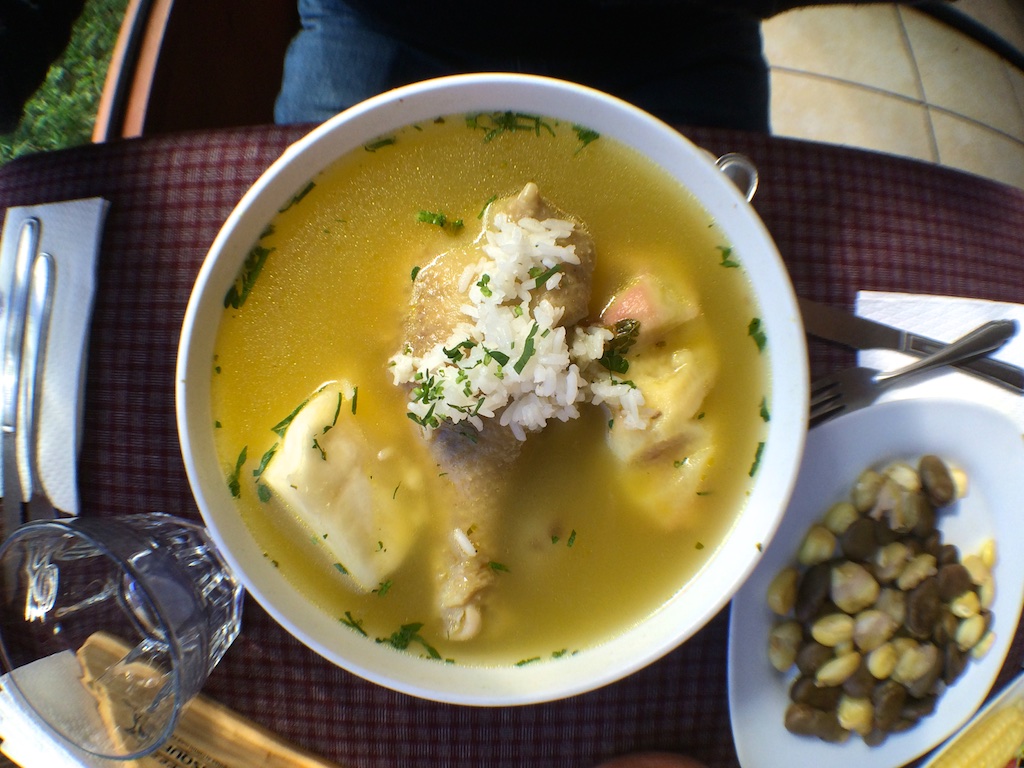
Curious in Cusco
They scare you to death about the altitude shift in Cusco BUT they neglect to tell you about the death defying commercial airline flight path decent. After an eventful corkscrew up over the Andes high peaks and then down into the puma shaped valley that is Cusco, Ant and I sipped our obligatory cocoa tea while watching the standard South American baggage claim chaos. Luckily neither of us have ever been effected much by oxygen deprivation, aggressive air flight or a conveyor belt vomiting cardboard boxes for 40 minutes. The coca tea was as much a placebo as a passer of time until our backpacks were finally on the baggage belt. Collected, we met our fixer, Anthony Herrera, just outside the small, cement terminal. “Mr. Anello” scribbled in black ink across an old postal envelope and his large Pre-Colombian Peruvian smile made him immediately spottable amongst the myriad of signs and guides.
Minutes later we were barreling around the main roundabout in Anthony’s miniature automobile. This was our first note of the Peruvian tourist symphony. A few minutes after that we were inside the glass doors of our hotel sipping more coca tea and listening to Anthony outline the plans for the next few days. We’d be spending a day in Cusco but then heading to the Sacred Valley and Machu Picchu (a separate post for sure) then return for another few days in Cusco.
The Inca trail to roasted chicken
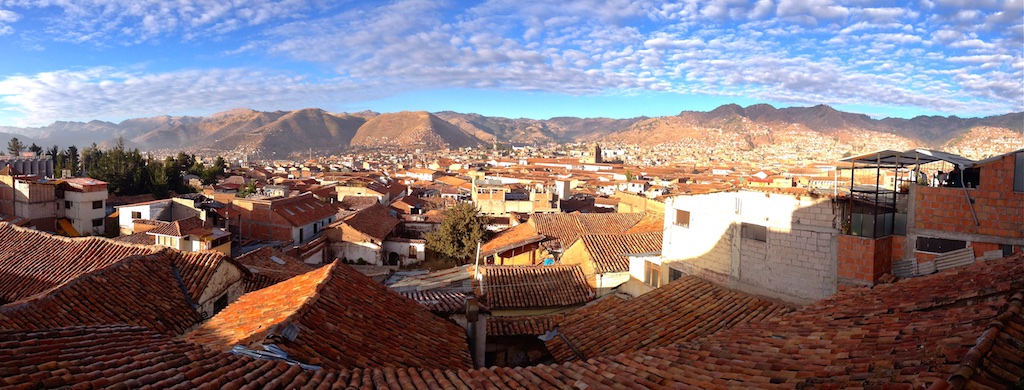 Although it was barely mid-day we decided to chill a minute in our room and take in the view our double wide, screenless, windows provided. The Cusco air was thin. Sound seemed to move quickly across the valley from great distances to our eardrums. Our stomach grumbles quickly muffled the exterior tones and we decided to head off for our first Cusco meal.
Although it was barely mid-day we decided to chill a minute in our room and take in the view our double wide, screenless, windows provided. The Cusco air was thin. Sound seemed to move quickly across the valley from great distances to our eardrums. Our stomach grumbles quickly muffled the exterior tones and we decided to head off for our first Cusco meal.
 When I saw the Alpaca on the menu and the open air clay oven in the center of the courtyard, there was no question as to what my order would be. Along with the moist and surprisingly flavorful skewer of llama, I had another Peruvian staple the rocoto relleno. First tasted in Lima a few days prior, this would be a recurring accouterment to many of my dishes on this entire trip. The restaurant was named Pachapapa, a play on the central deity of the Inca’s. At least this was our guess because we heard a lot about Pachamama but never heard about papa except plastered over the white adobo entrance to this open air restaurant. We later found out this was one of the places to try the famed roasted guinea pig. Brave as we are, we decided to give it a few days before attempting a meal that heavy.
When I saw the Alpaca on the menu and the open air clay oven in the center of the courtyard, there was no question as to what my order would be. Along with the moist and surprisingly flavorful skewer of llama, I had another Peruvian staple the rocoto relleno. First tasted in Lima a few days prior, this would be a recurring accouterment to many of my dishes on this entire trip. The restaurant was named Pachapapa, a play on the central deity of the Inca’s. At least this was our guess because we heard a lot about Pachamama but never heard about papa except plastered over the white adobo entrance to this open air restaurant. We later found out this was one of the places to try the famed roasted guinea pig. Brave as we are, we decided to give it a few days before attempting a meal that heavy.
After lunch we walked the streets down to the main square. Along the way we saw many remnants of Inca life. The tell tale interlocked blocks seemed to be around every bend of the tight streets.
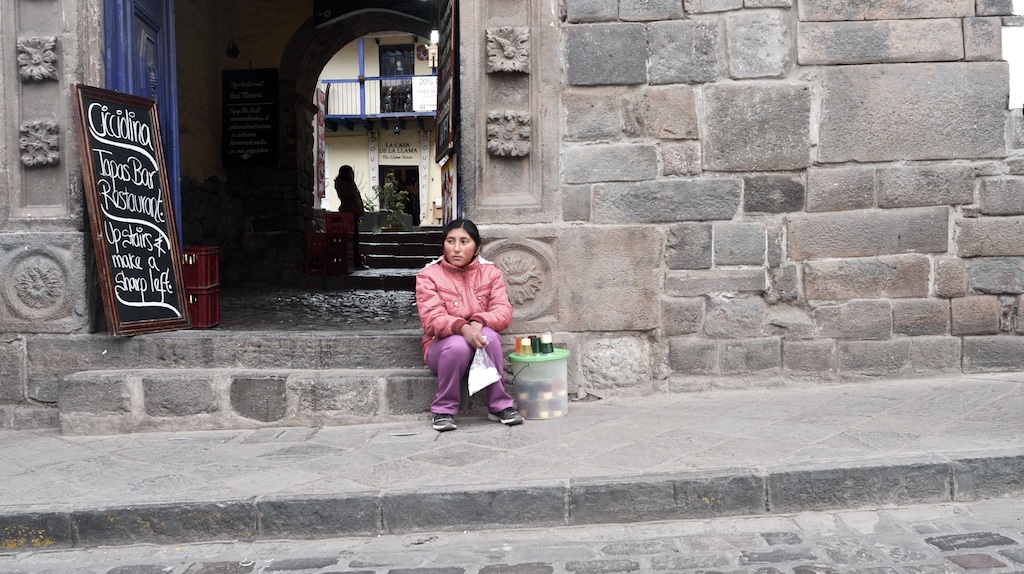 Aside from the architecture the streets were riddled with the hustle and bustle of Cusco life. Much of it geared towards tourists. As the hospitality symphony continued we heard the melody that makes up much of Cusco’s economy. Peru is a rough and tumble country. The tourist companies have made navigating this very, very easy. Normally we’d shun upon typical tourist traps but in this case its necessary to maximize your explorations. To expand on this, I don’t mean everything is a tourist bus to Kodak moments (Uhh…I mean selfie moments) although there is plenty of that. You can, as we do often on our trips, easily find yourself a guide for the day who can arrange a trip to anywhere you’d like to go. The cost is generally low and the arrangements can be made just 60 minutes in advance. In short, there is always someone ready to take you to it, from it, explain it, wait while you check it out, eat it, buy it or hike it.
Aside from the architecture the streets were riddled with the hustle and bustle of Cusco life. Much of it geared towards tourists. As the hospitality symphony continued we heard the melody that makes up much of Cusco’s economy. Peru is a rough and tumble country. The tourist companies have made navigating this very, very easy. Normally we’d shun upon typical tourist traps but in this case its necessary to maximize your explorations. To expand on this, I don’t mean everything is a tourist bus to Kodak moments (Uhh…I mean selfie moments) although there is plenty of that. You can, as we do often on our trips, easily find yourself a guide for the day who can arrange a trip to anywhere you’d like to go. The cost is generally low and the arrangements can be made just 60 minutes in advance. In short, there is always someone ready to take you to it, from it, explain it, wait while you check it out, eat it, buy it or hike it.
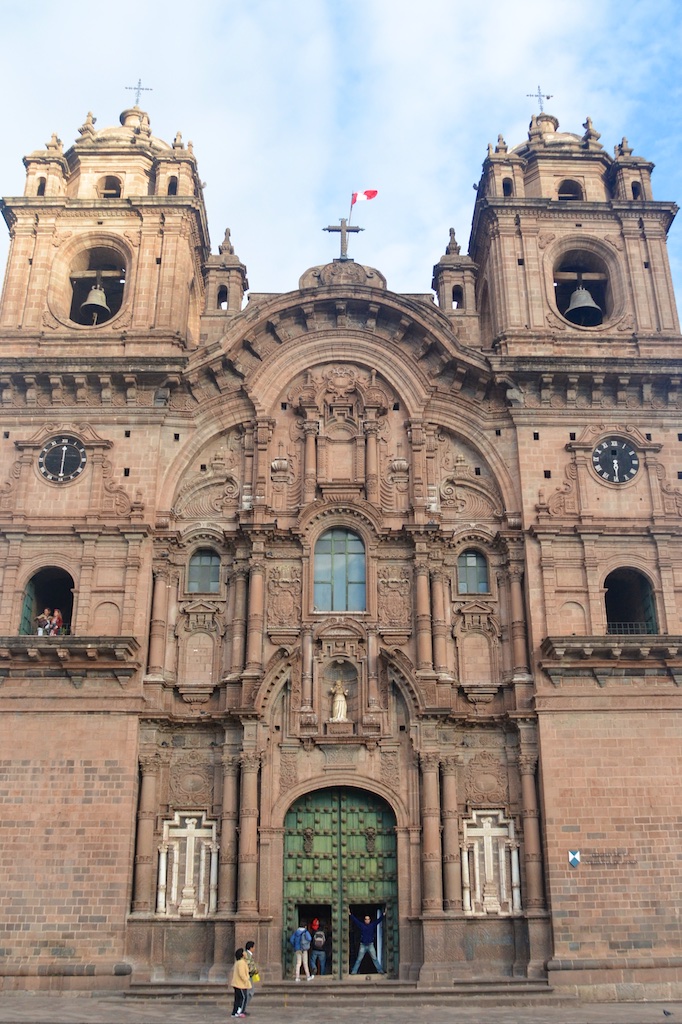 Finally in the main square, Plaza De Armas, we couldn’t help but snap every angle of our surroundings. A mini, urban valley of it’s own, the political and religious buildings dominated the finely landscaped center square. Less crowded than the narrow streets we just came from, we had some breathing room to take in the landscape from every vantage. Tucked in the archways that made up the less important perimeter buildings, Cusco natives and tourists shared the large cobblestone sidewalks.
Finally in the main square, Plaza De Armas, we couldn’t help but snap every angle of our surroundings. A mini, urban valley of it’s own, the political and religious buildings dominated the finely landscaped center square. Less crowded than the narrow streets we just came from, we had some breathing room to take in the landscape from every vantage. Tucked in the archways that made up the less important perimeter buildings, Cusco natives and tourists shared the large cobblestone sidewalks.
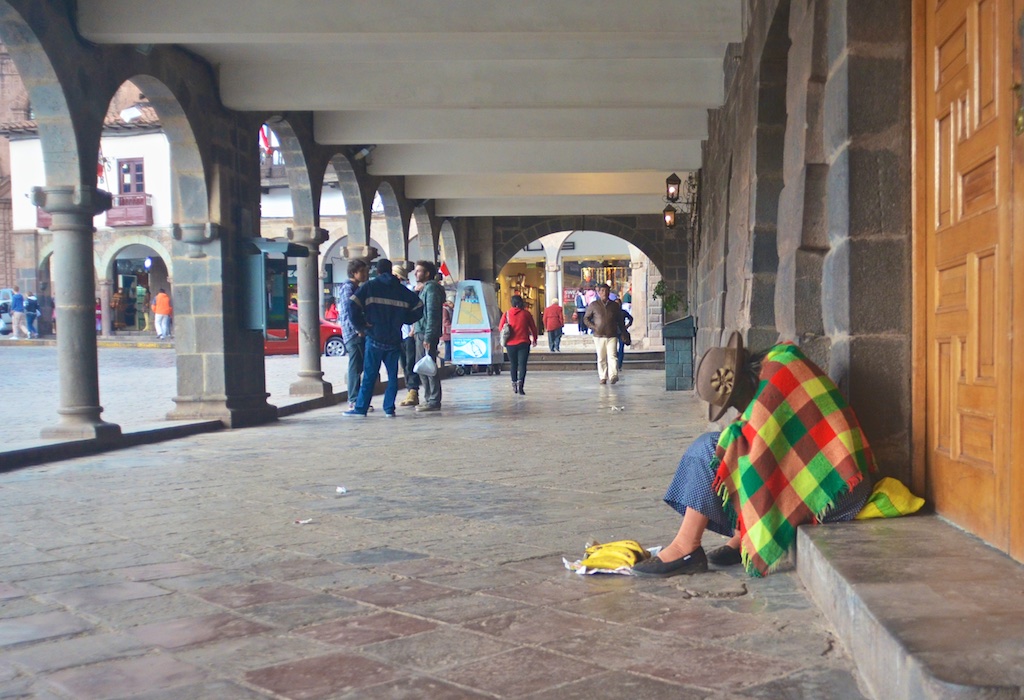 Before we new it, the sun had dropped and our bellies started asking for another round of Cusco goodness. Feeling no effects of the altitude we obliged with one of the best meals of the entire trip. The famous pollo a la brasa had been sidelined by Amazonian fare, molecular gastronomy and Raul (all worth it) while in Lima. We decided to remedy this by sliding into what locals claimed to be Cusco’s best. Los Toldos was crowded but not packed. Dark wood tables peppered the areas around the salad bar and large open rotisserie. There were at least 30 chickens spinning when we walked in. The staff were preparing three more giant skewers to get in the mix as well. This place was already holding up to its reco. Anyone spinning that many chickens at once must be doing something right. Our, soon to be standard, order of full bird, fries and salad came out quickly but we were not rushed to eat. Sign number two of a great joint.
Before we new it, the sun had dropped and our bellies started asking for another round of Cusco goodness. Feeling no effects of the altitude we obliged with one of the best meals of the entire trip. The famous pollo a la brasa had been sidelined by Amazonian fare, molecular gastronomy and Raul (all worth it) while in Lima. We decided to remedy this by sliding into what locals claimed to be Cusco’s best. Los Toldos was crowded but not packed. Dark wood tables peppered the areas around the salad bar and large open rotisserie. There were at least 30 chickens spinning when we walked in. The staff were preparing three more giant skewers to get in the mix as well. This place was already holding up to its reco. Anyone spinning that many chickens at once must be doing something right. Our, soon to be standard, order of full bird, fries and salad came out quickly but we were not rushed to eat. Sign number two of a great joint.
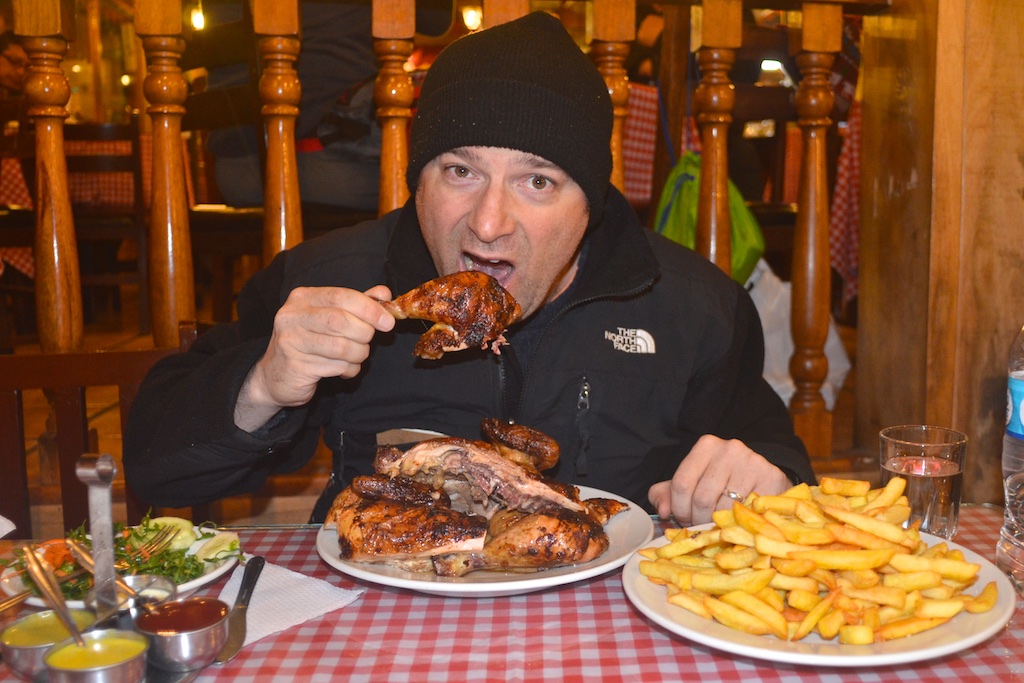 With all three items falling off their respective plates, we dug into the chicken first. Super moist, maxed out on flavor and the perfect temperature only broadened our grins. Tearing through the dark and white meat, with care not to lose any skin, was interrupted only by the occasional perfectly made fry. Green sauce, the national staple condiment, was not even necessary but added tons of extra value when we did decide to take a break from chewing. That night ended with a full belly and anticipation of our early rise the next morning to head to Machu Picchu. We’ll post that soon in this series.
With all three items falling off their respective plates, we dug into the chicken first. Super moist, maxed out on flavor and the perfect temperature only broadened our grins. Tearing through the dark and white meat, with care not to lose any skin, was interrupted only by the occasional perfectly made fry. Green sauce, the national staple condiment, was not even necessary but added tons of extra value when we did decide to take a break from chewing. That night ended with a full belly and anticipation of our early rise the next morning to head to Machu Picchu. We’ll post that soon in this series.
Quandary in Cusco
We arrived back in Cusco 3 days later. We switched up hotels, this time staying in the Novotel with it’s giant open courtyard and more reliable than customary internet connection. So reliable we could even Skype back to NYC. The X factor was if it was late enough and the bandwidth was freed up by most guests falling asleep, which did happen with consistancy. Score one for the oxygen deprivation.
After settling into our room we decided it was time we hit the local food scene hard. The obvious obscurity was roasted guinea pig, known as Cuy, but that just scratched the surface of the gastronomic, regional, taste temptations available at La Cusquenita. This turned out to be both a business lunch hot bed as well as a locals joint complete with traditional dance show every 10 minutes. We’re all for culture but it got tired quick. Luckily we were not in the main room due to the popularity of the restaurant so we were sidelined to a smaller room off to the side of the lobby garden. We started with the guinea pig. There are entire towns built around this dish. There are two ways you can get it. Roasted or fried, as in deep fried. We opted for the roasted which comes stuffed with an herb called Huacatay. If you found it wild, at first glance, it would look like the cannibis plant. It’s also known as black mint although does not resemble the mint we use here in the states in smell or taste. In fact, that was the killer of this dish. The guinea pig itself was pretty tasty, despite it tough to get to the meat because of the small bones. It’s a picking dish. A lot of work for little reward. The huacatay filled the organ cavity and was roasted along with the cuy. This brought an infused flavor of the herb to every bite and it was not pleasant. I later came to realize huacatay was the secret to the green sauce served with chicken but the tastes we’re worlds apart.
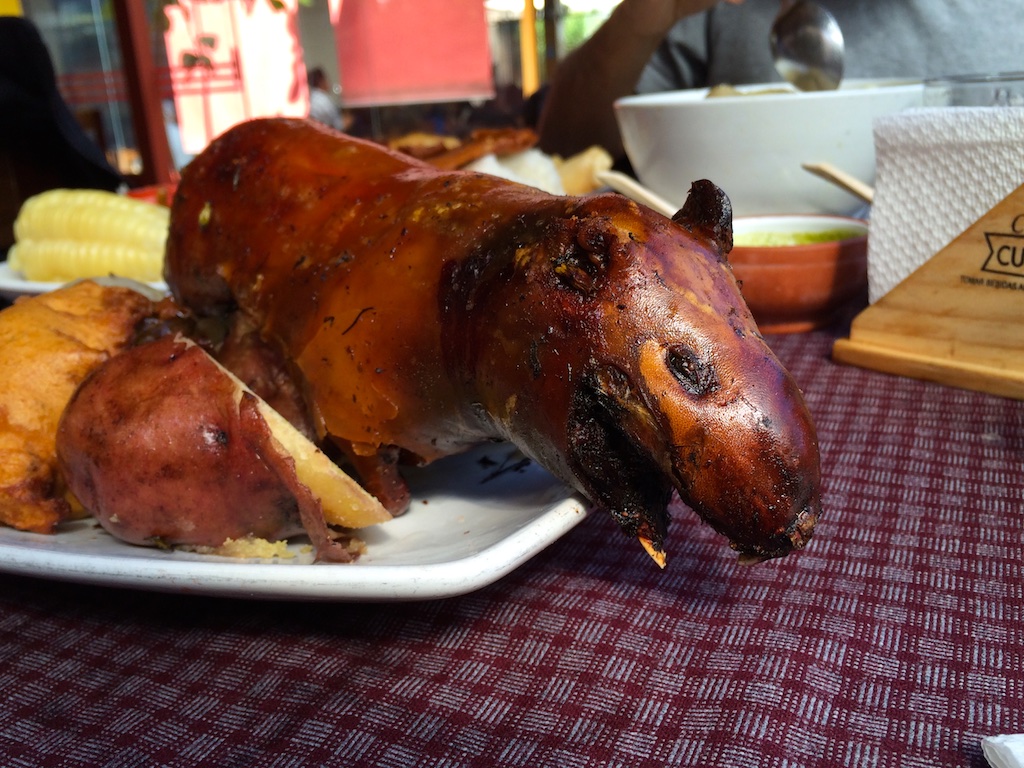 We moved off the guinea pig and worked into our next menu item, cow utter. I imagined it to be like haggis but it wasn’t. It WAS equally disgusting. Flavorless and fried. If I didn’t see it printed on a laminated menu I’d think the locals were teasing us by frying a random part of the cow off menu.
We moved off the guinea pig and worked into our next menu item, cow utter. I imagined it to be like haggis but it wasn’t. It WAS equally disgusting. Flavorless and fried. If I didn’t see it printed on a laminated menu I’d think the locals were teasing us by frying a random part of the cow off menu.
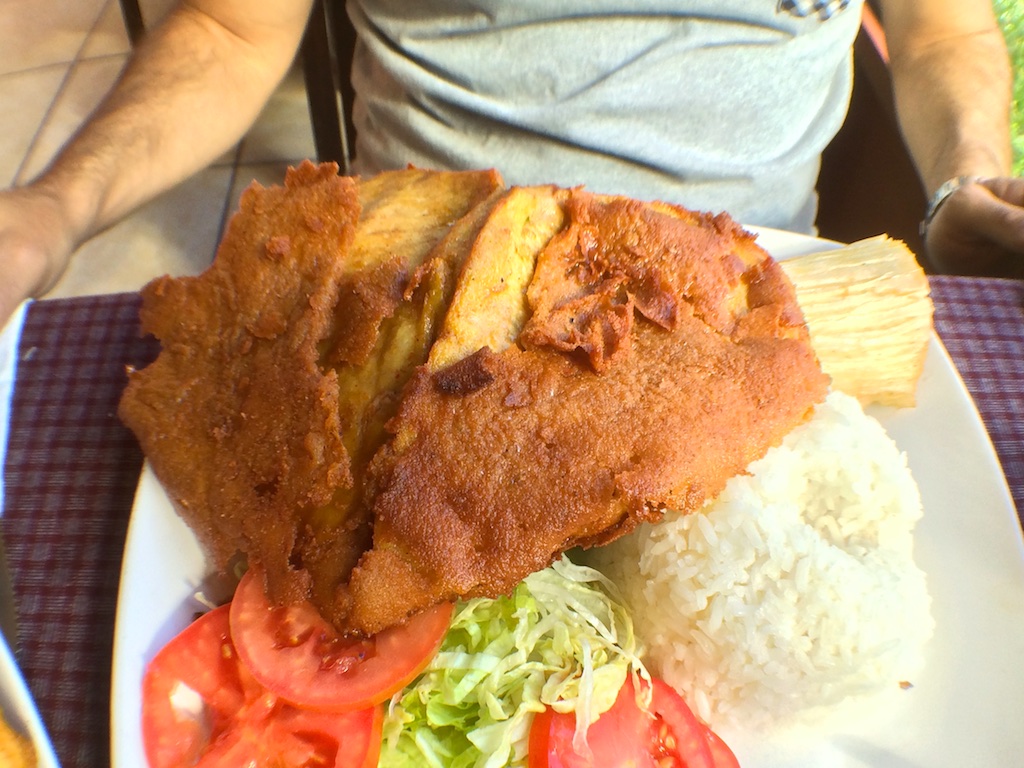 We couldn’t even get through two bites. Green sauce couldn’t even help this dish. Luckily we’d ordered some beers and rocoto relleno as a safety in case everything else was a fail. Which, it’s sad to say, everything else was. The effort and beauty of the below soup gave us hope. Even the smell had the potential for delicious. The lore of this soup might be the biggest of everything we ate on our “local specialties” menu the whole trip. Caldo gallina is Peru’s chicken noodle soup, hence the love from locals. Our guess is it reminds everyone of their childhood, a seemingly flavorless childhood. We couldn’t quite understand the tasteless broth, the bland dumplings or the rubber chicken leg. We tried to understand the mild flavors for what they were but couldn’t accept that this dish was tasty. Another fail leaving us with more questions. Is this really how these beloved dishes taste? They love this?
We couldn’t even get through two bites. Green sauce couldn’t even help this dish. Luckily we’d ordered some beers and rocoto relleno as a safety in case everything else was a fail. Which, it’s sad to say, everything else was. The effort and beauty of the below soup gave us hope. Even the smell had the potential for delicious. The lore of this soup might be the biggest of everything we ate on our “local specialties” menu the whole trip. Caldo gallina is Peru’s chicken noodle soup, hence the love from locals. Our guess is it reminds everyone of their childhood, a seemingly flavorless childhood. We couldn’t quite understand the tasteless broth, the bland dumplings or the rubber chicken leg. We tried to understand the mild flavors for what they were but couldn’t accept that this dish was tasty. Another fail leaving us with more questions. Is this really how these beloved dishes taste? They love this?
 With one of four dishes being edible we knew we needed to cut our losses and the biggest question of the day was posed. “How are we going to leave?” In situations like this we find there is no better way than to own it. Be bold. “We’re done. Thank you.” then get up and go. Dismiss the looks from servers saying, “But you hardly ate anything.” with their eyes and the people at the next table looking on with confusion. Most of it’s in your mind anyway. Hey, it happens. Every meal isn’t a winner and we think it’s important to tell these stories along with the mind blowingly tasty ones. We made our way past the main room and out the front door as the music from the 20th dance performance faded into the distance.
With one of four dishes being edible we knew we needed to cut our losses and the biggest question of the day was posed. “How are we going to leave?” In situations like this we find there is no better way than to own it. Be bold. “We’re done. Thank you.” then get up and go. Dismiss the looks from servers saying, “But you hardly ate anything.” with their eyes and the people at the next table looking on with confusion. Most of it’s in your mind anyway. Hey, it happens. Every meal isn’t a winner and we think it’s important to tell these stories along with the mind blowingly tasty ones. We made our way past the main room and out the front door as the music from the 20th dance performance faded into the distance.
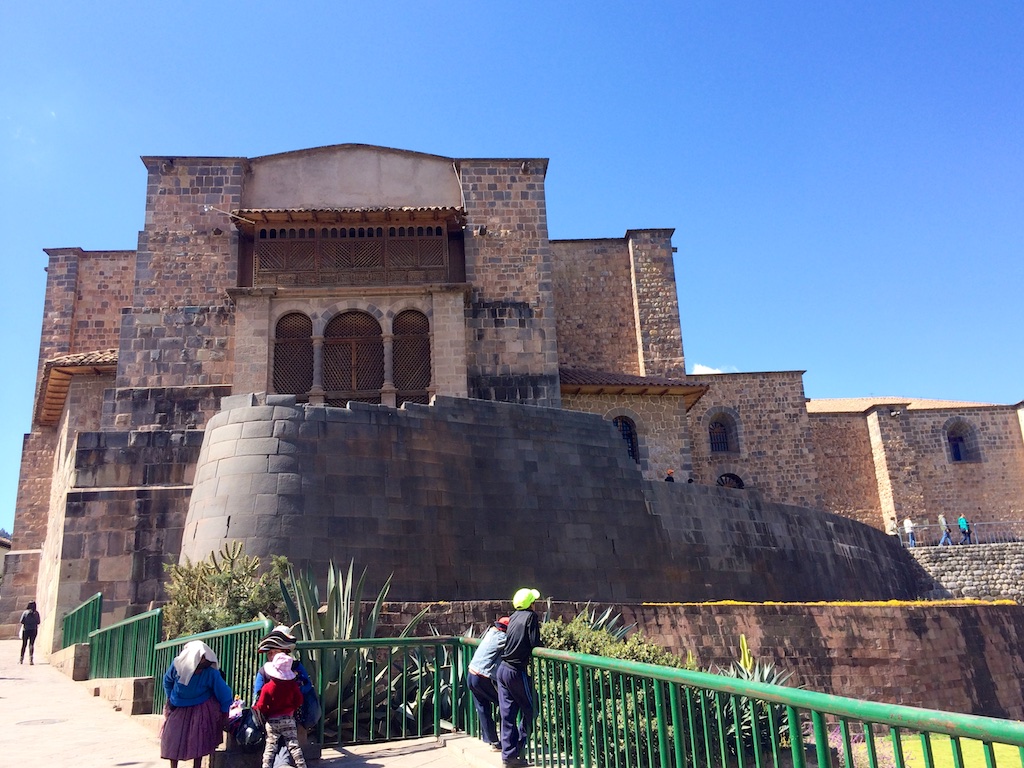 We redeemed our meal with a tour through this church. Notice the base and the top are very different architecture. That’s because the Spanish built the church of Santo Domingo directly on top of the Inca temple Coricancha (Qurikancha) to literally stomp out the enemy. Or, rightful land owners, however you choose to view this. This, Temple of the Sun, was one of the most important in the entire Inca empire. Now might be a good time to take a pause and give you the hard beats of the Inca empire and Spanish conquering. Here’s my bastardized version swiped from Wikipedia and The Ancient History Encyclopedia.
We redeemed our meal with a tour through this church. Notice the base and the top are very different architecture. That’s because the Spanish built the church of Santo Domingo directly on top of the Inca temple Coricancha (Qurikancha) to literally stomp out the enemy. Or, rightful land owners, however you choose to view this. This, Temple of the Sun, was one of the most important in the entire Inca empire. Now might be a good time to take a pause and give you the hard beats of the Inca empire and Spanish conquering. Here’s my bastardized version swiped from Wikipedia and The Ancient History Encyclopedia.
1100 The Inca migrate to the Cuzco Valley
1425 Begin building the Inca empire
1450 Pachacuti builds Machu Picchu
1471 Coricancha (the sun temple) built in Cusco
1493 Empire doubles in size
1510 Machu Picchu abandoned
1526 Inca finishes constructing temples and roads throughout the empire
1526 Pizzaro makes first contact with Inca at Tumbes
1528 Emperor Huayna Capac dies of smallpox
1528 Civil war between his sons begins.
1530 The Inca empire reaches its greatest extent
1532 Atahualpa wins the civil war then is captured by the Spanish
1533 Pizarro takes the Inca capital of Cuzco
1535 Pizarro founds Lima as the capital of Spanish Peru
1559 Church built on top of Inca temple.
Some of that will become important in a future post but to recap. The incas were awesome. They built a gold temple. Pizarro came and gave them smallpox. He then built a church on top of their temple in the biggest FU of the century.
Besides the church/temple tour, the Inca temple was excavated so you could see the two in full view. The museum part of this landmark explained a lot about the history of the Spanish and the Incas with the contrast of their two buildings of worship exposed at every turn. Of all the tourist paths in Cusco, this one we think is well worth the visit. Pet a baby lamb on the way out and buy some palo santos and move on to your next bite.
 Our next bite was another Gastón Acurio spot, Chicha. A second floor restaurant required us to pass by some performers practicing their show in the courtyard for the restaurant on the ground floor. We love you Gastón but nothing remarkable about the meal. We’re we getting too accustomed to the diverse and new flavor profiles of Peru?
Our next bite was another Gastón Acurio spot, Chicha. A second floor restaurant required us to pass by some performers practicing their show in the courtyard for the restaurant on the ground floor. We love you Gastón but nothing remarkable about the meal. We’re we getting too accustomed to the diverse and new flavor profiles of Peru?
Stars and teeth aligned
With fresh legs and stomachs, we rose early to attack the main market, San Pedro, and speak with some guides about where to go after Cusco. We were looking to get into the Amazon jungle, maybe through Iquitos, but we didn’t know if that was possible. After about an hour of guide hoping and being told jungle fever (Malaria) pills could be bought on site, we realized how unprepared we were for the rawness of the jungle. We mentally decided an Amazon trip will need to be arranged as a trip all its own. On to the market we went.
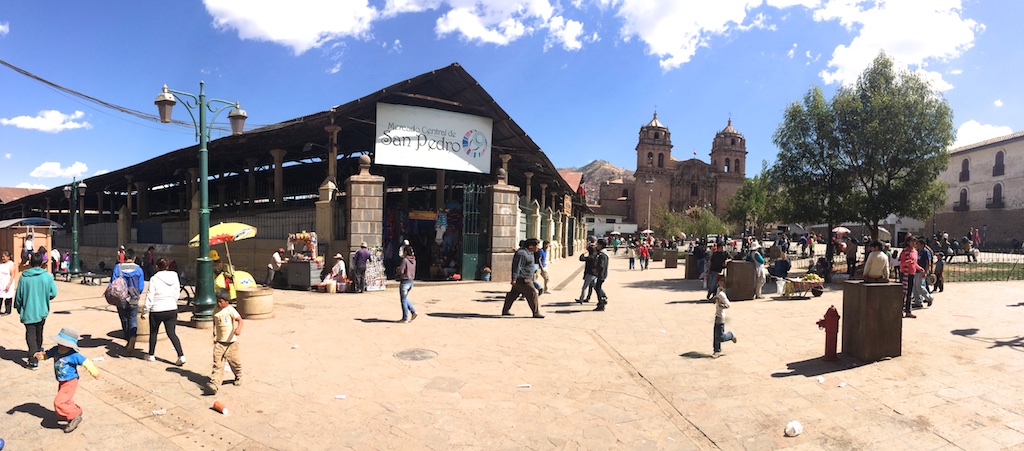 This chapter will be mostly visual but there was a moment that would come to light later in the evening that was…well…in a cliched yet literal and figurative sense, cosmic.
This chapter will be mostly visual but there was a moment that would come to light later in the evening that was…well…in a cliched yet literal and figurative sense, cosmic.
San Pedro is like most other markets. Fruit, veggies, meats, conveniences and of course, grains. We are in Peru. Hello Quinoa? Expecting more of the same as Lima we were moving through the different areas fairly swiftly until we started seeing things we’ve never, EVER, seen before. ANYWHERE. Not India. Not Singapore. Not that crazy ass little village outside of Sapa, Vietnam. Cusco wins, so far, for craziest market food. Be warned, the below is NOT for the faint of heart.
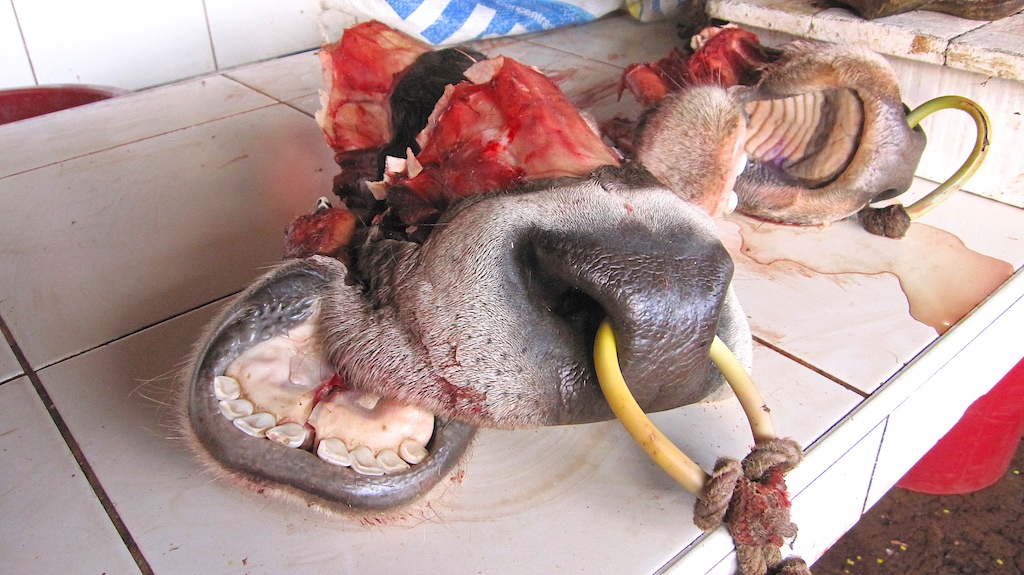 Yeah…that’s what we thought too. Stopped us dead in our tracks.
Yeah…that’s what we thought too. Stopped us dead in our tracks. 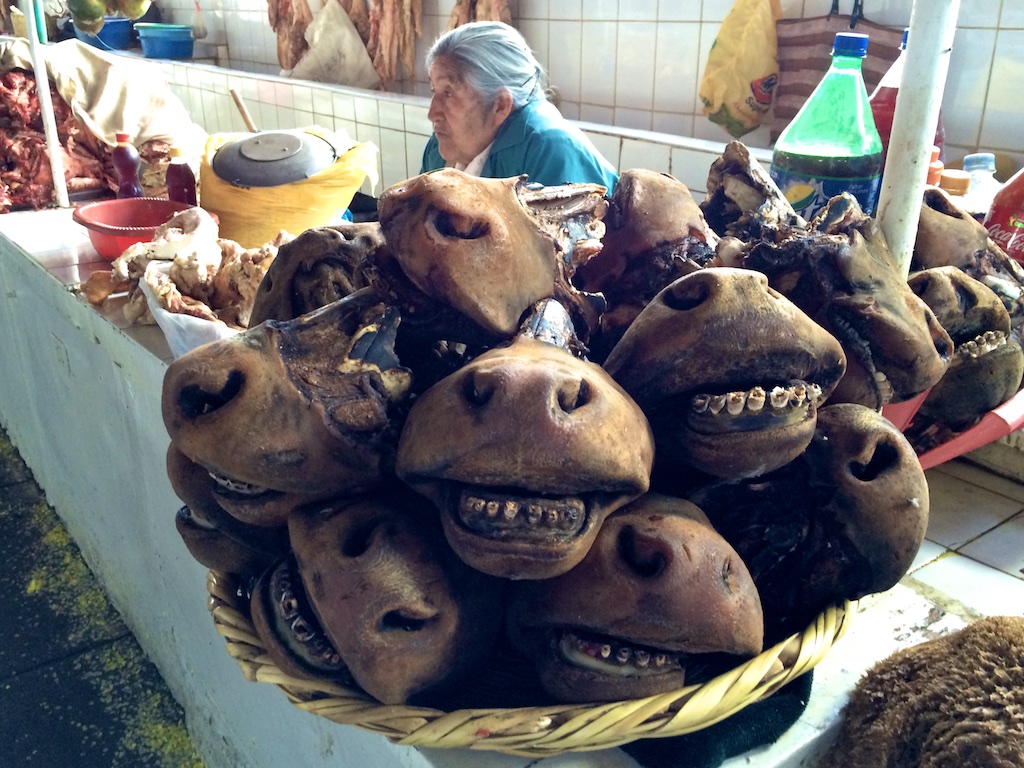 Then we saw the basket of smoked ones. I love the normalcy on the vendors face. “Just another day selling my smoked, roasted, baked…whatever, donkey faces.” These snouts and the bovine above are both used by home cooks to make rich broths. Of course we were intrigued but came up short securing some of this highly radical broth.
Then we saw the basket of smoked ones. I love the normalcy on the vendors face. “Just another day selling my smoked, roasted, baked…whatever, donkey faces.” These snouts and the bovine above are both used by home cooks to make rich broths. Of course we were intrigued but came up short securing some of this highly radical broth.
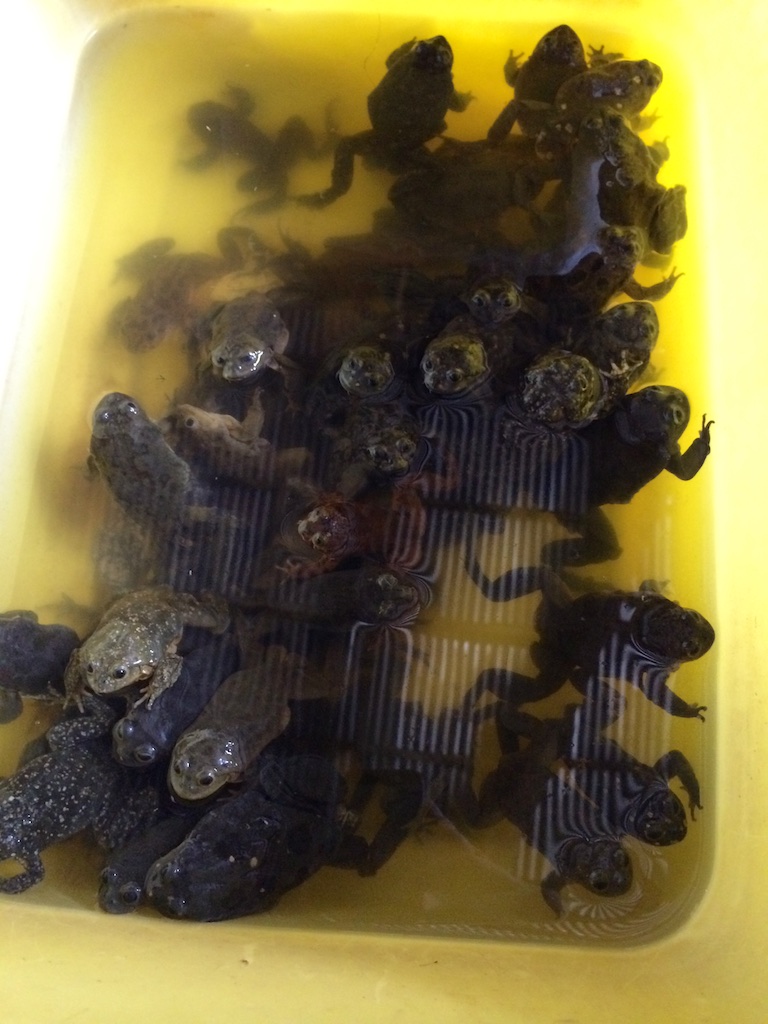 Frogs. Not the craziest but we still think that’s on the far end of market merchandise.
Frogs. Not the craziest but we still think that’s on the far end of market merchandise. 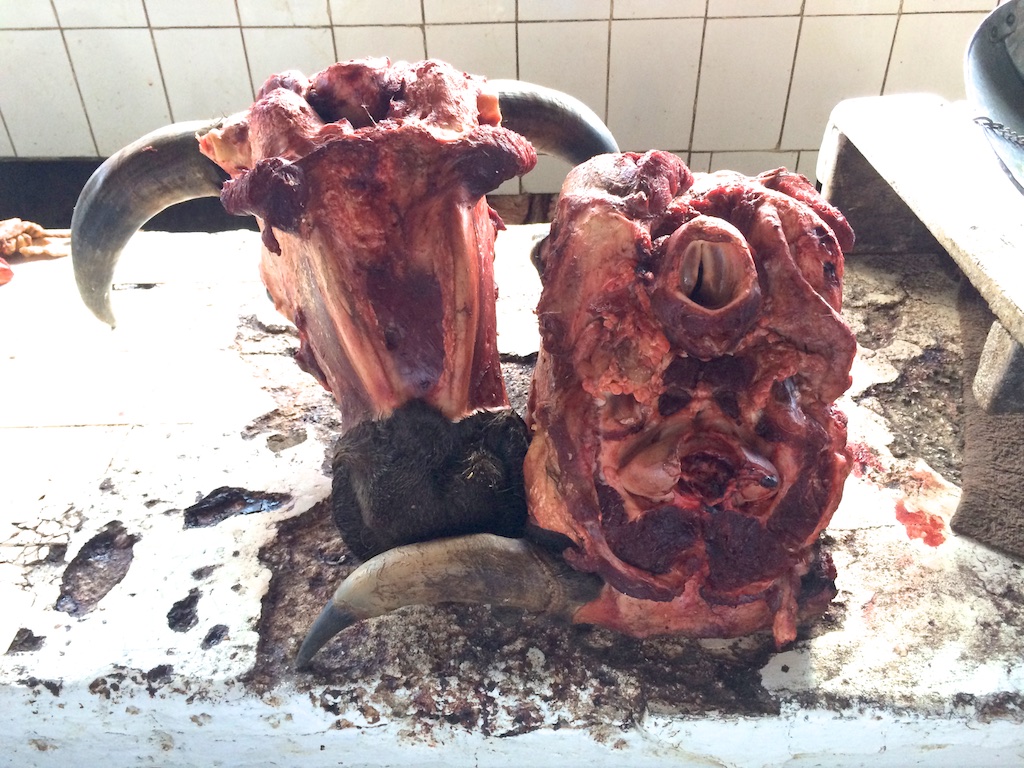 Believe it or not, snout was more shocking than this. A skinned ox head should make us freak a bit right? What I loved about this most was the presentation. Something about displaying an open windpipe contrasted against the lower jaw brings it all together.
Believe it or not, snout was more shocking than this. A skinned ox head should make us freak a bit right? What I loved about this most was the presentation. Something about displaying an open windpipe contrasted against the lower jaw brings it all together. 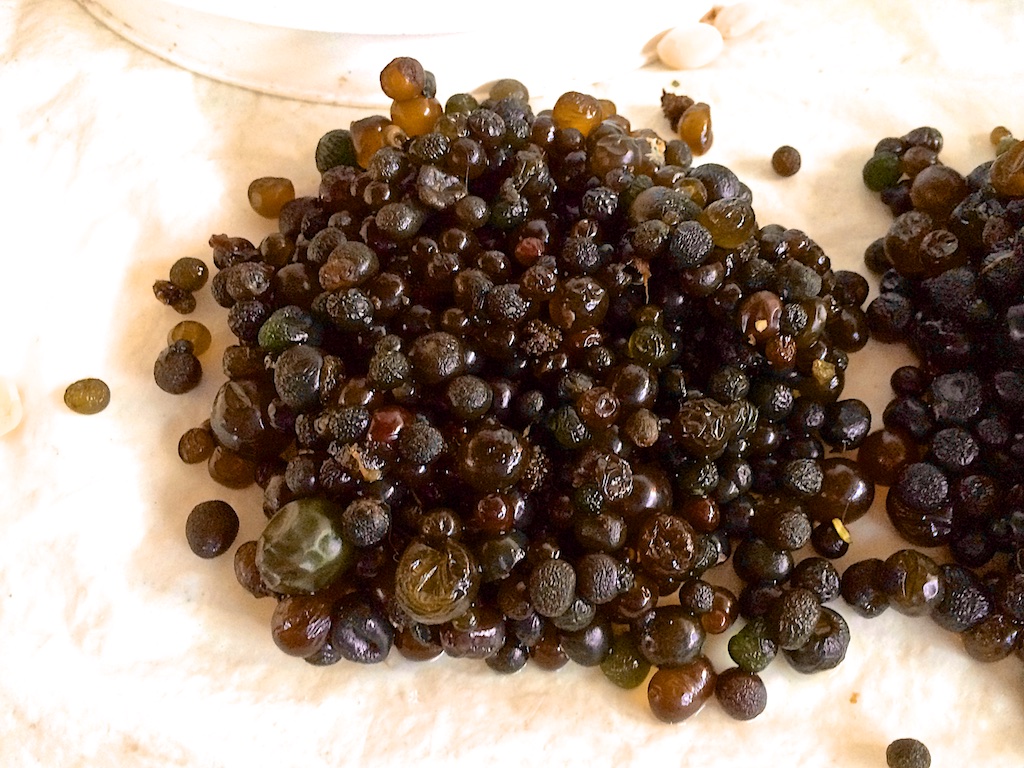 This cushuro isn’t too outrageous by sight but when I tell you it’s bacteria you can see how it fits with the other sensational items we’ve captured here. We first had it, unknowingly of origin and composition, in our Central meal back in Lima. Cushuro grows in small lagoons, springs, wetlands and freshwater pools at very high altitudes. We’re talking 11, 800+ feet above sea level. It makes sense why it’s prevalent in the Cusco market. The Franks explain this visually (minute 13:50) in their Peru episode. The Mater crew does a great job explaining the more technical here. They also happen to be the ones with the Franks in the harvesting clip.
This cushuro isn’t too outrageous by sight but when I tell you it’s bacteria you can see how it fits with the other sensational items we’ve captured here. We first had it, unknowingly of origin and composition, in our Central meal back in Lima. Cushuro grows in small lagoons, springs, wetlands and freshwater pools at very high altitudes. We’re talking 11, 800+ feet above sea level. It makes sense why it’s prevalent in the Cusco market. The Franks explain this visually (minute 13:50) in their Peru episode. The Mater crew does a great job explaining the more technical here. They also happen to be the ones with the Franks in the harvesting clip.
 We’re still not sure what this was. We think dried, baby, sheep. Why? is a totally different question. Also, unanswered.
We’re still not sure what this was. We think dried, baby, sheep. Why? is a totally different question. Also, unanswered.
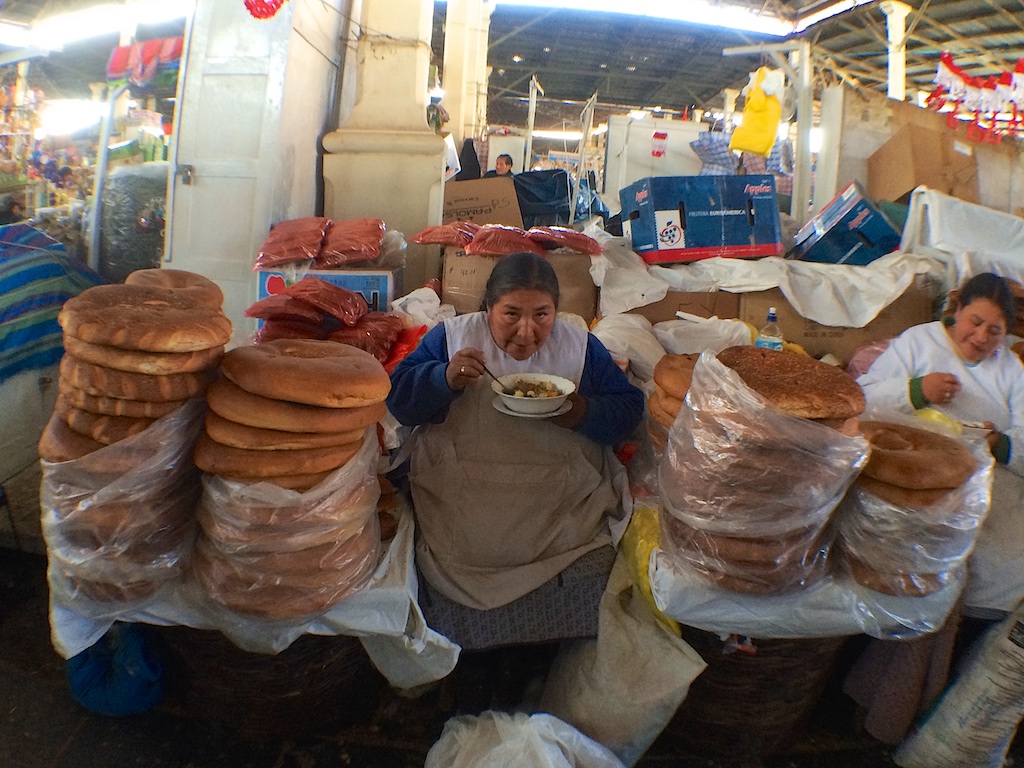
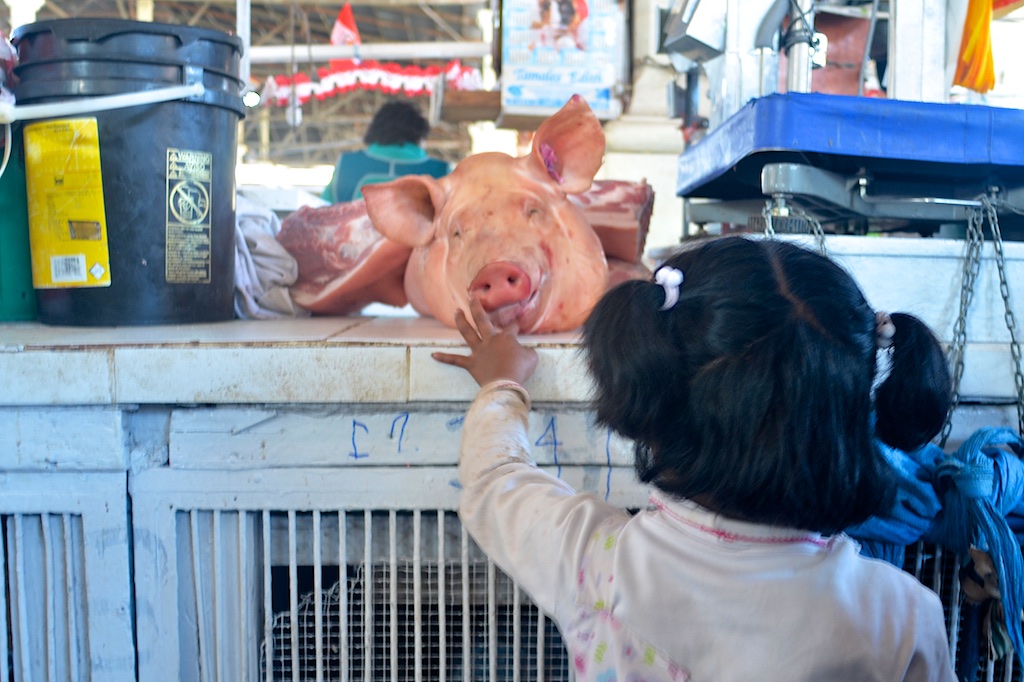 Curious in Cusco.
Curious in Cusco.
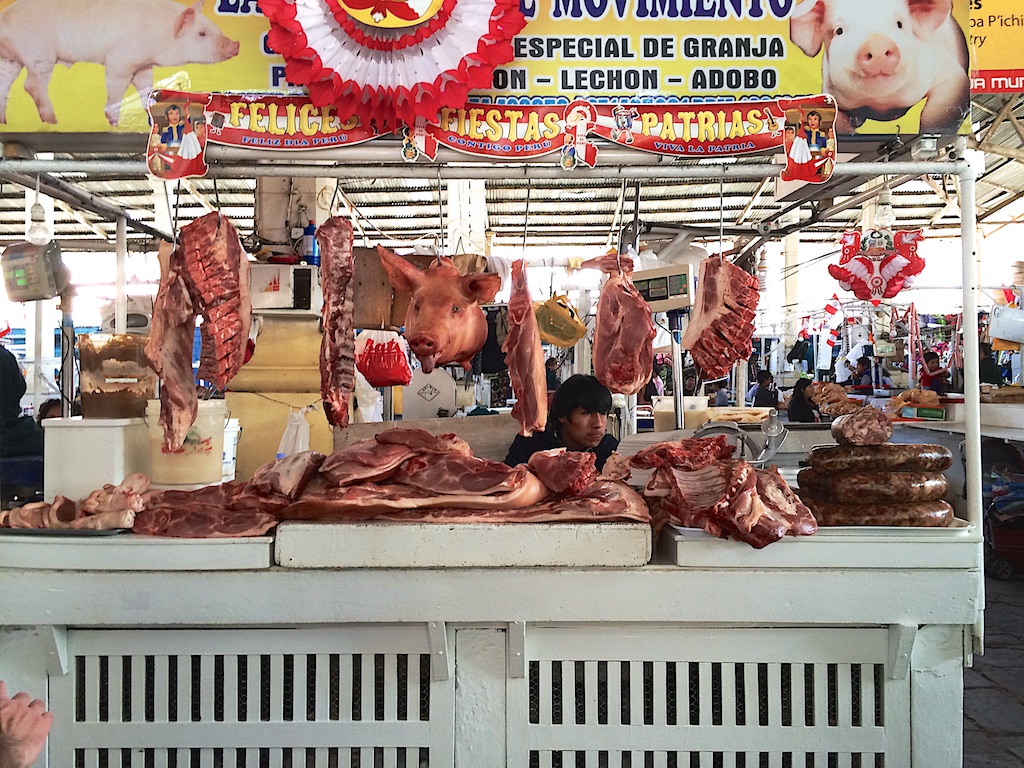 This was the shot that I referenced earlier as cosmic. What seemed like a simple picture I snapped about a hanging pig head and a young vendor was actually more about what happened on the opposite side of the lens. This begun the cosmic part of our Peru adventure. We’ll cover that in our next installment as well as round out our final days in Cusco. For now go shake those snout visuals off with a brisk walk.
This was the shot that I referenced earlier as cosmic. What seemed like a simple picture I snapped about a hanging pig head and a young vendor was actually more about what happened on the opposite side of the lens. This begun the cosmic part of our Peru adventure. We’ll cover that in our next installment as well as round out our final days in Cusco. For now go shake those snout visuals off with a brisk walk.


